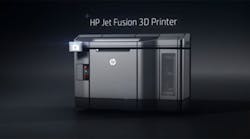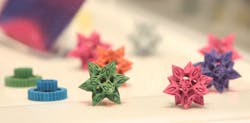SAN DIEGO — New products, new industries, new leadership and, of course, new companies. Yeah, these last two years have been unlike any in the nearly-eight-decade history of the tech leader formerly known as Hewlett-Packard.
Tim Weber was one of the hundreds of thousands of employees affected when the old company split back in November 2015 into Hewlett Packard Enterprise, which focuses more on services, software and financial, and HP Inc., which develops computers, printers and other related supplies. For years, Weber was responsible for a lot of that 2-D printer technology, especially from the ink jet standpoint, that so many of us use at home and at the office. “We built the print heads,” he said, “from $100 printers to $10 million printers.” Since late 2015, though, he has been the global head of HP’s 3D materials and advanced applications.
“It was a bit of a new area,” Weber said, “but the way HP often works is we sort of sponsor new things in the core business. That’s what we were doing. A lot of things that go into 3D are leveraged from 2D. It was a very logical transformation. The difference is the business aspect of it. In 2-D land, the businesses have been set for HP for years. In 3D land, we have the opportunity to kind of create some new business models in an open materials platform.
“That was a journey of discovery for me, and probably for others.”
HP has been on some kind of journey of discovery ever since, investing more and more resources into its burgeoning 3D printing business. Its first announcements about the tech came just three years ago. It introduced the hardware last year, partnered with some big-name manufacturers (BMW, Johnson & Johnson, Nike and, as outlined in an IndustryWeek feature last year, Jabil Circuits were all foundational partners) and went about disrupting a disruptive industry. Earlier this month, company officials announced a move into Asia, and just last week, Investor’s Business Daily reported that HP’s scaling of its 3D printing business could threaten market leaders 3D Systems and Stratasys. Heady times.
“We’ve reached the point where we are starting to scale the business,” Weber said. “We expect to sell a lot more units and we expect to start to see them going more from people just testing them out and prototyping to short-run manufacturing. Maybe customers who have one are looking to buy more and scale up. From a materials standpoint, we expect to start to introduce more and more materials on a regular basis. We’re letting the materials companies run with that.
“I think we’re most interested in working with folks who are thinking about 3D from a transformational manufacturing standpoint. We chose all of (our foundational partners) because they’re not thinking about prototyping. They’re trying to figure out how to move into it from a manufacturing standpoint, and materials companies are the same.”
To read a Q&A with Weber and to learn more about HP's 3D printing plans, continue reading on IndustryWeek.












